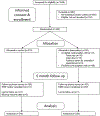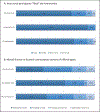A Novel Approach to Postpartum Contraception Provision Combined with Infant Care: A Randomized, Controlled Trial
- PMID: 31964564
- PMCID: PMC8696743
- DOI: 10.1016/j.whi.2019.12.001
A Novel Approach to Postpartum Contraception Provision Combined with Infant Care: A Randomized, Controlled Trial
Abstract
Background: Unintended pregnancy among women with short interpregnancy intervals remains common. Women's attendance at the 4- to 6-week postpartum visit, when contraception provision often occurs, is low, whereas their attendance at well-baby visits is high. We aimed to evaluate if offering co-located contraceptive services to mothers at well-baby visits increases use of long-acting reversible contraception (LARC) at 5 months postpartum compared with usual care in a randomized, controlled trial.
Methods: Women with infants aged 4.5 months or younger who were not using a LARC method and had not undergone sterilization were eligible. Generalized linear models were used to estimate risk ratios. Likability and satisfaction of the contraception visit were assessed.
Results: Between January 2015 and January 2017, 446 women were randomized. LARC use at 5 months was 19.1% and 20.9% for the intervention and control groups, respectively, and was not significantly different after controlling for weeks postpartum (risk ratio, 0.85; 95% confidence interval, 0.59-1.23). Uptake of the co-located visit was low (17.7%), but the concept was liked; insufficient time to stay for the visit was the biggest barrier to uptake. Women who accepted the visit were more likely to use a LARC method at 5 months compared with women in the control group (risk ratio, 1.97; 95% confidence interval, 1.26-3.07).
Conclusions: Women perceived co-located care favorably and LARC use was higher among those who completed a visit; however, uptake was low for reasons including inability to stay after the infant visit. Intervention effects were possibly diluted. Future research should test a version of this intervention designed to overcome barriers that participants reported.
Copyright © 2019 Jacobs Institute of Women's Health. Published by Elsevier Inc. All rights reserved.
Figures
Similar articles
-
Mapping Long-acting Reversible Contraceptive Interventions to the Social Ecological Model: A Scoping Review.Womens Health Issues. 2023 Sep-Oct;33(5):497-507. doi: 10.1016/j.whi.2023.06.005. Epub 2023 Jul 25. Womens Health Issues. 2023. PMID: 37500420 Free PMC article.
-
Factors associated with postpartum use of long-acting reversible contraception.Am J Obstet Gynecol. 2019 Jul;221(1):43.e1-43.e11. doi: 10.1016/j.ajog.2019.03.005. Epub 2019 Mar 15. Am J Obstet Gynecol. 2019. PMID: 30885772 Free PMC article.
-
Factors associated with short interpregnancy interval in women who plan postpartum LARC: a retrospective study.Contraception. 2017 Mar;95(3):245-250. doi: 10.1016/j.contraception.2016.08.012. Epub 2016 Aug 30. Contraception. 2017. PMID: 27589883
-
Prenatal Contraceptive Counseling by Video.South Med J. 2019 Jan;112(1):8-13. doi: 10.14423/SMJ.0000000000000913. South Med J. 2019. PMID: 30608623 Clinical Trial.
-
Current evidence of contraceptive uptake, pregnancy and continuation rates in young women: a systematic review and Meta-analysis.Eur J Contracept Reprod Health Care. 2020 Dec;25(6):492-501. doi: 10.1080/13625187.2020.1833187. Eur J Contracept Reprod Health Care. 2020. PMID: 33140990
Cited by
-
Optimizing Access to Preventive Reproductive Health Care: Meeting Patients Where They Are At.Am J Public Health. 2021 Feb;111(2):209-211. doi: 10.2105/AJPH.2020.306043. Am J Public Health. 2021. PMID: 33439700 Free PMC article. No abstract available.
-
A Scoping Review of Patient-Centered Perinatal Contraceptive Counseling.Matern Child Health J. 2024 Sep;28(9):1454-1484. doi: 10.1007/s10995-024-03946-y. Epub 2024 Aug 1. Matern Child Health J. 2024. PMID: 39088140 Free PMC article.
-
Mapping Long-acting Reversible Contraceptive Interventions to the Social Ecological Model: A Scoping Review.Womens Health Issues. 2023 Sep-Oct;33(5):497-507. doi: 10.1016/j.whi.2023.06.005. Epub 2023 Jul 25. Womens Health Issues. 2023. PMID: 37500420 Free PMC article.
-
Postpartum Family Planning in Pediatrics: A Survey of Parental Contraceptive Needs and Health Services Preferences.Acad Pediatr. 2023 Sep-Oct;23(7):1417-1425. doi: 10.1016/j.acap.2023.03.009. Epub 2023 Mar 22. Acad Pediatr. 2023. PMID: 36958531 Free PMC article.
-
"An Act of Complete Care": Provider Perspectives on Linking Maternal Contraceptive Care With Well-Baby Visits in Community Health Centers.J Prim Care Community Health. 2024 Jan-Dec;15:21501319241277421. doi: 10.1177/21501319241277421. J Prim Care Community Health. 2024. PMID: 39245894 Free PMC article.
References
-
- Bryant AS, Haas JS, McElrath TF, & McCormick MC (2006). Predictors of compliance with the postpartum visit among women living in healthy start project areas. Maternal and child health journal, 10(6), 511–516. - PubMed
-
- CDC. (2011). National Survey of Children’s Health - State and local area integrated telephone survey.
Publication types
MeSH terms
Grants and funding
LinkOut - more resources
Full Text Sources
Medical



